Major religious groups
The world's principal religions and spiritual traditions may be classified into a small number of major groups, although this is not a uniform practice. This theory began in the 18th century with the goal of recognizing the relative levels of civility in societies[2] (which in many modern cultures would be considered offensive).
History of religious categories
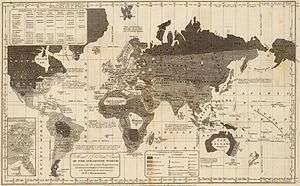

In world cultures, there have traditionally been many different groupings of religious belief. In Indian culture, different religious philosophies were traditionally respected as academic differences in pursuit of the same truth. In Islam, the Quran mentions three different categories: Muslims, the People of the Book, and idol worshipers.
Christian categorizations
Initially, Christians had a simple dichotomy of world beliefs: Christian civility versus foreign heresy or barbarity. In the 18th century, "heresy" was clarified to mean Judaism and Islam;[3] along with paganism, this created a fourfold classification which spawned such works as John Toland's Nazarenus, or Jewish, Gentile, and Mahometan Christianity,[4] which represented the three Abrahamic religions as different "nations" or sects within religion itself, the "true monotheism."
Daniel Defoe described the original definition as follows: "Religion is properly the Worship given to God, but 'tis also applied to the Worship of Idols and false Deities."[5] At the turn of the 19th century, in between 1780 and 1810, the language dramatically changed: instead of "religion" being synonymous with spirituality, authors began using the plural, "religions," to refer to both Christianity and other forms of worship. Therefore, Hannah Adams's early encyclopedia, for example, had its name changed from An Alphabetical Compendium of the Various Sects... to A Dictionary of All Religions and Religious Denominations.[6][7]
In 1838, the four-way division of Christianity, Judaism, Mahommedanism (archaic terminology for Islam) and Paganism was multiplied considerably by Josiah Conder's Analytical and Comparative View of All Religions Now Extant among Mankind. Conder's work still adhered to the four-way classification, but in his eye for detail he puts together much historical work to create something resembling the modern Western image: he includes Druze, Yezidis, Mandeans, and Elamites[8] under a list of possibly monotheistic groups, and under the final category, of "polytheism and pantheism," he listed Zoroastrianism, "Vedas, Puranas, Tantras, Reformed sects" of India as well as "Brahminical idolatry," Buddhism, Jainism, Sikhism, Lamaism, "religion of China and Japan," and "illiterate superstitions" as others.[9][10]
The modern meaning of the phrase "world religion," putting non-Christians at the same level as Christians, began with the 1893 Parliament of the World's Religions in Chicago. The Parliament spurred the creation of a dozen privately funded lectures with the intent of informing people of the diversity of religious experience: these lectures funded researchers such as William James, D. T. Suzuki, and Alan Watts, who greatly influenced the public conception of world religions.[11]
In the latter half of the 20th century, the category of "world religion" fell into serious question, especially for drawing parallels between vastly different cultures, and thereby creating an arbitrary separation between the religious and the secular.[12] Even history professors have now taken note of these complications and advise against teaching "world religions" in schools.[13] Others see the shaping of religions in the context of the nation-state as the "invention of traditions."
Classification
Religious traditions fall into super-groups in comparative religion, arranged by historical origin and mutual influence. Abrahamic religions originate in West Asia,[14][15] Indian religions in the Indian subcontinent (South Asia)[16] and East Asian religions in East Asia.[17] Another group with supra-regional influence are Afro-American religion,[18] which have their origins in Central and West Africa.
- Middle Eastern religions:[19]
- Abrahamic religions are the largest group, and these consist mainly of Judaism, Christianity, Islam, and the Bahá'í Faith. They are named for the patriarch Abraham, and are unified by the practice of monotheism. Today, at least 3.8 billion people are followers of Abrahamic religions[20] and are spread widely around the world apart from the regions around East and Southeast Asia. Several Abrahamic organizations are vigorous proselytizers.[21]
- Iranian religions, partly of Indo-European origins,[22][23] include Zoroastrianism, Yazdânism, Uatsdin, Yarsanism and historical traditions of Gnosticism (Mandaeism, Manichaeism).
- Indian religions, originated in Greater India and they tend to share a number of key concepts, such as dharma, karma, reincarnation among others. They are of the most influence across the Indian subcontinent, East Asia, Southeast Asia, as well as isolated parts of Russia. The main Indian religions are Hinduism, Jainism, Buddhism and Sikhism.
- East Asian religions consist of several East Asian religions which make use of the concept of Tao (in Chinese) or Dō (in Japanese or Korean). They include many Chinese folk religions, Taoism and Confucianism, as well as Korean and Japanese religion influenced by Chinese thought.
- African religions:[19]
- The religions of the tribal peoples of Sub-Saharan Africa, but excluding ancient Egyptian religion, which is considered to belong to the ancient Middle East;[19]
- African diasporic religions practiced in the Americas, imported as a result of the Atlantic slave trade of the 16th to 18th centuries, building on traditional religions of Central and West Africa.
- Indigenous ethnic religions, found on every continent, now marginalized by the major organized faiths in many parts of the world or persisting as undercurrents (folk religions) of major religions. Includes traditional African religions, Asian shamanism, Native American religions, Austronesian and Australian Aboriginal traditions, Chinese folk religions, and postwar Shinto. Under more traditional listings, this has been referred to as "paganism" along with historical polytheism.
- New religious movement is the term applied to any religious faith which has emerged since the 19th century, often syncretizing, re-interpreting or reviving aspects of older traditions such as Ayyavazhi, Mormonism, Ahmadiyya, Pentecostalism, polytheistic reconstructionism, and so forth.
Religious demographics
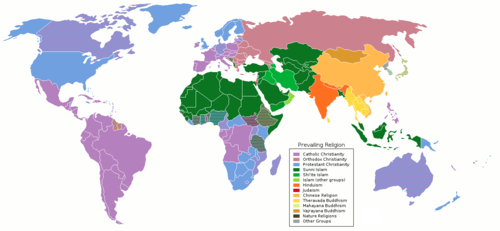
One way to define a major religion is by the number of current adherents. The population numbers by religion are computed by a combination of census reports and population surveys (in countries where religion data is not collected in census, for example the United States or France), but results can vary widely depending on the way questions are phrased, the definitions of religion used and the bias of the agencies or organizations conducting the survey. Informal or unorganized religions are especially difficult to count.
There is no consensus among researchers as to the best methodology for determining the religiosity profile of the world's population. A number of fundamental aspects are unresolved:
- Whether to count "historically predominant religious culture[s]"[24]
- Whether to count only those who actively "practice" a particular religion[25]
- Whether to count based on a concept of "adherence"[26]
- Whether to count only those who expressly self-identify with a particular denomination[27]
- Whether to count only adults, or to include children as well.
- Whether to rely only on official government-provided statistics[28]
- Whether to use multiple sources and ranges or single "best source(s)"
Largest religious groups
| Religion | Followers (billions) | Cultural tradition | Founded | References |
|---|---|---|---|---|
| Christianity | 2.4 | Abrahamic religions | Middle East | [29][30] |
| Islam | 1.8 | Abrahamic religions | Middle East | [31][32] |
| Hinduism | 1.2 | Indian religions | Indian subcontinent | [29] |
| Buddhism | 0.52 | Indian religions | Indian subcontinent | [30] |
| Folk religion | 0.4 | Depends on the region | Worldwide | [33] |
Medium-sized religions
| Religion | Followers (millions) | Cultural tradition | Founded | References |
|---|---|---|---|---|
| Taoism | 12–173 | Chinese religions | China | [34] |
| Shinto | 100 | Japanese religions | Japan | [35][36] |
| Falun Gong | 80–100 | Chinese religions | China, 20th century | [37] |
| Sikhism | 30 | Indian religions | Indian subcontinent, 15th century | [38] |
| Judaism | 14.5 | Abrahamic religions | Levant (Middle East) | [29][39] |
| Confucianism | 6–7 | Chinese religions | China | [40] |
| Spiritism | 5-15 | New religious movements | France | [41] |
| Korean shamanism | 5–15 | Korean religions | Korea | [42] |
| Caodaism | 5–9 | Vietnamese religions | Vietnam, 20th century | [43] |
| Bahá'í Faith | 5–7.3 | Abrahamic religions | Iran, 19th century | [44][45][nb 1] |
| Tenriism | 5 | Japanese religions | Japan, 19th century | [46] |
| Jainism | 4-5 | Indian religions | Indian subcontinent, 7th to 9th century BC | [47][48] |
| Cheondoism | 3–4 | Korean religions | Korea, 19th century | [49] |
| Hoahaoism | 1.5–3 | Vietnamese religions | Vietnam, 20th century | [50] |
By region
- Religions by country according to The World Factbook - CIA[51]
- Religion by region
- Religion in Africa
- Religion in Antarctica
- Religion in Asia
- Religion in the Middle East
- Muslim world (SW Asia and N Africa)
- Religion in Europe
- Religion in North America
- Religion in Oceania
- Religion in South America
Trends in adherence
World Christian Encyclopedia
Following is some available data based on the work of the World Christian Encyclopedia:[52]
| 1970–1985[53] | 1990–2000[54][55] | 2000–2005[56] | % change 1970–2010 (40 yrs)[45] |
|---|---|---|---|
| 3.65%: Bahá'í Faith | 2.65%: Zoroastrianism | 1.84%: Islam | 9.85%: Daoism |
| 2.74%: Islam | 2.28%: Bahá'í Faith | 1.70%: Bahá'í Faith | 4.26%: Bahá'í Faith |
| 2.34%: Hinduism | 2.13%: Islam | 1.62%: Sikhism | 4.23%: Islam |
| 1.67%: Buddhism | 1.87%: Sikhism | 1.57%: Hinduism | 3.08%: Sikhism |
| 1.64%: Christianity | 1.69%: Hinduism | 1.32%: Christianity | 2.76%: Buddhism |
| 1.09%: Judaism | 1.36%: Christianity | 2.62%: Hinduism | |
| 1.09%: Buddhism | 2.60%: Jainism | ||
| 2.50%: Zoroastrianism | |||
| across 40 yrs, world total 2.16% | |||
| 2.10%: Christianity | |||
| 0.83%: Confucianism | |||
| 0.37%: unaffiliated (inc. atheists, agnostics, religious but not affiliated) | |||
| -0.03%: Judaism | |||
| -0.83%: Shintoism |
Maps of self-reported adherence
 Map showing self-reported religiosity by country. Based on a 2015 worldwide survey by Pew.
Map showing self-reported religiosity by country. Based on a 2015 worldwide survey by Pew.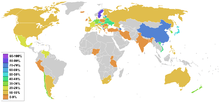 World map showing the percentages of people who regard religion as "non-important" according to a 2002 Pew survey
World map showing the percentages of people who regard religion as "non-important" according to a 2002 Pew survey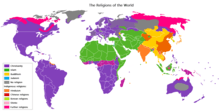 Religions of the world, mapped by distribution.
Religions of the world, mapped by distribution. Map showing the prevalence of "Abrahamic religion" (purple), and "Indian religion" (yellow) religions in each country.
Map showing the prevalence of "Abrahamic religion" (purple), and "Indian religion" (yellow) religions in each country. Map showing the relative proportion of Christianity (red) and Islam (green) in each country as of 2006
Map showing the relative proportion of Christianity (red) and Islam (green) in each country as of 2006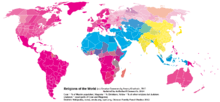
See also
Notes
- Historically, the Bahá'í Faith arose in 19th-century Persia, in the context of Shia Islam, and thus may be classed on this basis as a divergent strand of Islam, placing it in the Abrahamic tradition. However, the Bahá'í Faith considers itself an independent religious tradition, which draws from Islam but also other traditions. The Bahá'í Faith may also be classed as a new religious movement, due to its comparatively recent origin, or may be considered sufficiently old and established for such classification to not be applicable.
References
- Hackett, Conrad; Mcclendon, David (2015). "Christians remain world's largest religious group, but they are declining in Europe". Pew Research Center.
- Masuzawa, Tomoko (2005). The Invention of World Religions. Chicago University of Chicago Press. ISBN 978-0-226-50989-1.
- Glaser, Daryl; Walker, David M. (12 September 2007). Twentieth-Century Marxism: A Global Introduction. Routledge. ISBN 9781135979744.
- Toland, John; La Monnoye, Bernard de (1 January 1718). Nazarenus, or, Jewish, gentile, and Mahometan Christianity : containing the history of the antient Gospel of Barnabas, and the modern Gospel of the Mahometans ... also the original plan of Christianity explain'd in the history of the Nazarens ... with the relation of an Irish manuscript of the four Gospels, as likewise a summary of the antient Irish Christianity. London : J. Brotherton, J. Roberts and A. Dodd.
- Masuzawa, Tomoko (26 April 2012). The Invention of World Religions: Or, How European Universalism Was Preserved in the Language of Pluralism. University of Chicago Press. ISBN 9780226922621.
- Masuzawa 2005. pp. 49–61
- Masuzawa, Tomoko (26 April 2012). The Invention of World Religions: Or, How European Universalism Was Preserved in the Language of Pluralism. University of Chicago Press. ISBN 9780226922621.
- Masuzawa, Tomoko (26 April 2012). The Invention of World Religions: Or, How European Universalism Was Preserved in the Language of Pluralism. University of Chicago Press. ISBN 9780226922621.
- Masuzawa 2005, pp. 65–6
- Masuzawa, Tomoko (26 April 2012). The Invention of World Religions: Or, How European Universalism Was Preserved in the Language of Pluralism. University of Chicago Press. ISBN 9780226922621.
- Masuzawa 2005, 270–281
- Stephen R. L. Clark. "World Religions and World Orders". Religious studies 26.1 (1990).
- Joel E. Tishken. "Ethnic vs. Evangelical Religions: Beyond Teaching the World Religion Approach". The History Teacher 33.3 (2000).
- Spirituality and Psychiatry - Page 236, Chris Cook, Andrew Powell, A. C. P. Sims - 2009
- "Abraham, Father of the Middle East". www.dangoor.com. Retrieved 8 November 2016.
- "The Religions of the Indian Subcontinent Stretch Back for Millennia". About.com Education. Retrieved 8 November 2016.
- Neusner, Jacob (7 October 2009). World Religions in America, Fourth Edition: An Introduction. Westminster John Knox Press. ISBN 9781611640472.
- Neusner, Jacob (7 October 2009). World Religions in America, Fourth Edition: An Introduction. Westminster John Knox Press. ISBN 9781611640472.
- "classification of religions | Principles & Significance". Encyclopedia Britannica.
- Statistician, Howard Steven Friedman; Teacher, health economist for the United Nations; University, Columbia (25 April 2011). "5 Religions with the Most Followers | Huffington Post". The Huffington Post. Retrieved 8 November 2016.
- Brodd, Jeffrey (2003). World Religions. Winona, Minnesota: Saint Mary's Press. ISBN 978-0-88489-725-5.
- Samuel 2010.
- Anthony 2007.
- Pippa Norris; Ronald Inglehart (6 January 2007), Sacred and Secular, Religion and Politics Worldwide, Cambridge University Press, pp. 43–44, retrieved 29 December 2006
- Pew Research Center (19 December 2002). "Among Wealthy Nations U.S. Stands Alone in its Embrace of Religion". Pew Research Center. Retrieved 12 October 2006.
- adherents.com (28 August 2005). "Major Religions of the World Ranked by Number of Adherents". adherents.com. Retrieved 12 October 2006.
- worldvaluessurvey.org (28 June 2005). "World Values Survey". worldvaluessurvey.org. Retrieved 12 October 2006.
- unstats.un.org (6 January 2007). "United Nations Statistics Division - Demographic and Social Statistics". United Nations Statistics Division. Retrieved 6 January 2007.
- "The Global Religious Landscape". The Pew Forum on Religion & Public Life. Pew Research center. 18 December 2012. Retrieved 18 March 2013.
- "Christianity 2015: Religious Diversity and Personal Contact" (PDF). gordonconwell.edu. January 2015. Archived from the original (PDF) on 25 May 2017. Retrieved 29 May 2015.
- "Christianity 2015: Religious Diversity and Personal Contact" (PDF). gordonconwell.edu. January 2015. Archived from the original (PDF) on 25 May 2017. Retrieved 29 May 2015.
- "Why Muslims are the world's fastest-growing religious group". Pew Research Center. 6 April 2017. Retrieved 11 May 2017.
- "Folk Religionists". pewforum.org. Pew Research Center. December 2012. Retrieved 18 December 2012.
- 2010 Chinese Spiritual Life Survey conducted by the Purdue University's Center on Religion and Chinese Society. Statistics published in: Katharina Wenzel-Teuber, David Strait. People's Republic of China: Religions and Churches Statistical Overview 2011 Archived 3 March 2016 at the Wayback Machine. On: Religions & Christianity in Today's China, Vol. II, 2012, No. 3, pp. 29-54, ISSN 2192-9289.
- "Major Religions Ranked by Size". Adherents.com. Retrieved 24 June 2010.
- "Japan: International Religious Freedom Report 2006". Bureau of Democracy, Human Rights, and Labor; U.S. Department of State. 15 September 2006. Retrieved 24 June 2010.
- Jessica Gelt, "Falun Gong, banned in China, finds a loud protest voice in the U.S. through Shen Yun dance troupe", Los Angeles Times, 9 April 2016.
- "Sikhism". Encyclopædia Britannica. Retrieved 7 August 2017.
- "Jewish Population of the World". www.jewishvirtuallibrary.org. Retrieved 18 December 2018.
- Johnson, Todd M.; Grim, Brian J. (2013). The World's Religions in Figures: An Introduction to International Religious Demography (PDF). Hoboken, NJ: Wiley-Blackwell. p. 10. Archived from the original (PDF) on 20 October 2013. Retrieved 24 November 2015.
- "Tabela 2102: População residente por situação do domicílio, religião e sexo". sidra.ibge.gov.br.
- Self-reported figures from 1999; North Korea only (South Korean followers are minimal according to census). In The A to Z of New Religious Movements by George D. Chryssides. ISBN 0-8108-5588-7.
- Sergei Blagov. "Caodaism in Vietnam : Religion vs Restrictions and Persecution Archived 9 October 2011 at the Wayback Machine". IARF World Congress, Vancouver, Canada, July 31, 1999.
- Other Religions. Pew Forum report.
- Grim, Brian J (2012). "Rising restrictions on religion" (PDF). International Journal of Religious Freedom. 5 (1): 17–33. ISSN 2070-5484. Archived from the original (PDF) on 28 July 2013. Retrieved 25 April 2013.
- Self-reported figures printed in Japanese Ministry of Education's 宗教年間 Shuukyou Nenkan, 2003
- Voorst 2014, p. 96.
- "Jainism". Encyclopædia Britannica. Retrieved 7 August 2017.
- Self-reported figures from North Korea (South Korean followers are minimal according to census): "Religious Intelligence UK report". Religious Intelligence. Religious Intelligence. Archived from the original on 13 October 2007. Retrieved 4 July 2009.
- Janet Alison Hoskins. What Are Vietnam's Indigenous Religions?. Center for Southeast Asian Studies Kyoto University.
- "The World Factbook – Central Intelligence Agency". www.cia.gov. Retrieved 8 November 2016.
- The results have been studied and found "highly correlated with other sources of data", but "consistently gave a higher estimate for percent Christian in comparison to other cross-national data sets." Hsu, Becky; Reynolds, Amy; Hackett, Conrad; Gibbon, James (9 July 2008). "Estimating the Religious Composition of All Nations". Journal for the Scientific Study of Religion. 47 (4): 678. doi:10.1111/j.1468-5906.2008.00435.x.
- International Community, Bahá'í (1992). "How many Bahá'ís are there?". The Bahá'ís. p. 14..
- Barrett, David A. (2001). World Christian Encyclopedia. p. 4. ISBN 978-0-19-507963-0.
- Barrett, David; Johnson, Todd (2001). "Global adherents of the World's 19 distinct major religions" (PDF). William Carey Library. Archived from the original (PDF) on 28 February 2008. Retrieved 12 October 2006.
- Staff (May 2007). "The List: The World's Fastest-Growing Religions". Foreign Policy. Carnegie Endowment for International Peace. Retrieved 25 December 2013.
Sources
- Anthony, David W. (2007), The Horse, the Wheel and Language: how Bronze-Age riders from the Eurasian Steppes shaped the modern world, Princeton University Press
- Samuel, Geoffrey (2010), The Origins of Yoga and Tantra: Indic Religions to the Thirteenth Century, Cambridge University Press
- Voorst, Robert E. Van (2014), RELG: World (2 ed.), Cengage Learning, ISBN 978-1-285-43468-1 [1]
External links
- Animated history of World Religions—from the "Religion & Ethics" part of the BBC website, interactive animated view of the spread of world religions (requires Flash plug-in).
- BBC A-Z of Religions and Beliefs
- Major World Religions
- International Council for Inter-Religious Cooperation
- Voorst 2014, p. 111.